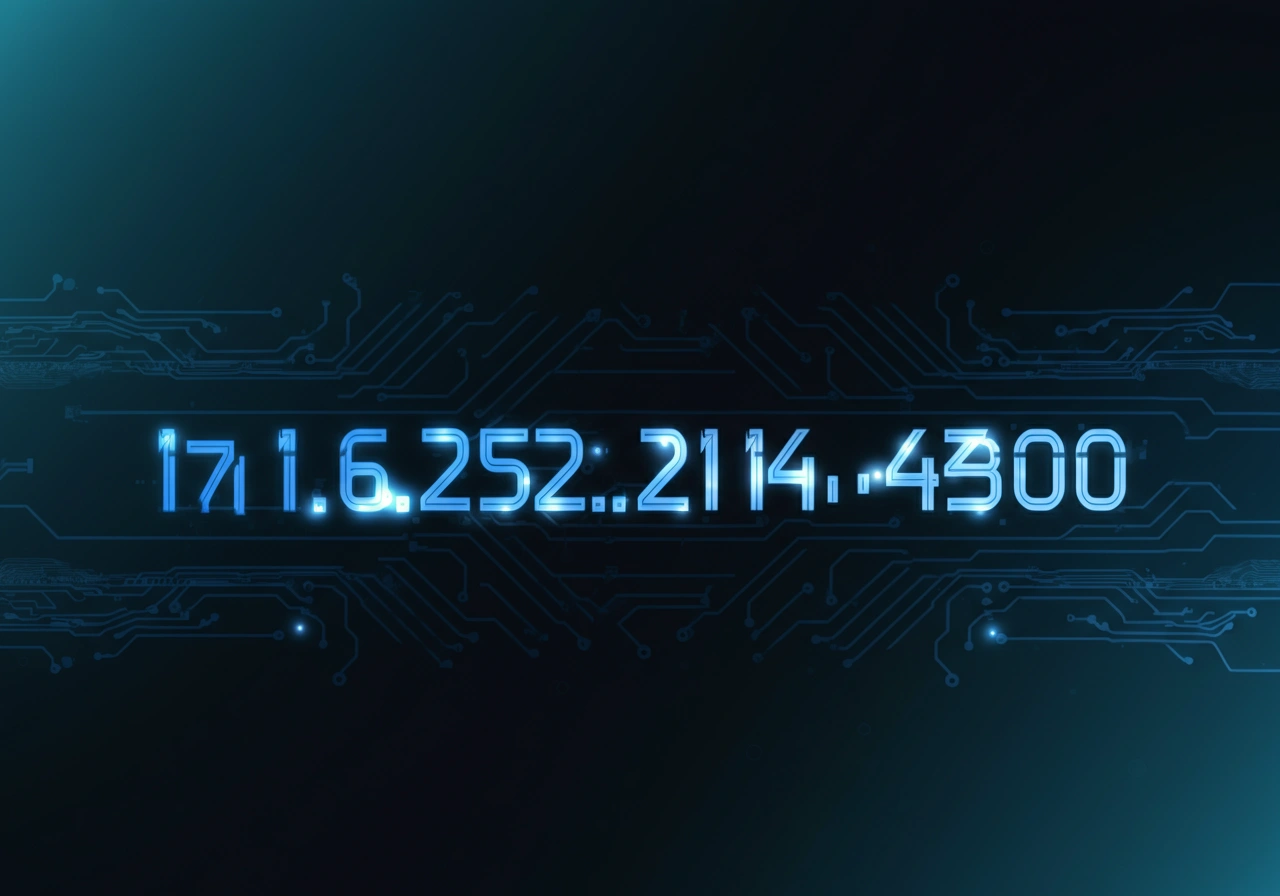Every time you connect to the internet or access a device on your network, your computer uses specific addresses to find and communicate with other machines. One such address you might encounter is 172.16.252.214:4300. But what does this combination of numbers actually mean, and why should you care?
This guide will break down the components of 172.16.252.214:4300, explaining how IP addresses and port numbers work together to enable network communication. Whether you’re troubleshooting a connection issue, configuring a local server, or simply curious about how networks function, understanding these fundamentals will give you greater control over your digital environment.
Understanding IP Addresses
An IP address (Internet Protocol address) serves as a unique identifier for devices on a network. Think of it as a digital street address that allows data to find its way to the correct destination. Without IP addresses, devices wouldn’t be able to locate each other or exchange information.
IPv4 vs. IPv6
There are two main versions of IP addresses in use today:
- IPv4: The older and more common format, using 32-bit addresses written as four numbers separated by periods (e.g., 192.168.1.1). This system supports approximately 4.3 billion unique addresses.
- IPv6: A newer format designed to solve IPv4’s address shortage, using 128-bit addresses written in hexadecimal format (e.g., 2001:0db8:85a3:0000:0000:8a2e:0370:7334).
The address 172.16.252.214 is an IPv4 address, composed of four octets (numbers ranging from 0 to 255) separated by dots.
Private vs. Public IP Addresses
Not all IP addresses are created equal. They fall into two main categories:
Public IP addresses are globally unique and routable on the internet. Your internet service provider assigns these to your home or business network, allowing devices to communicate across the world.
Private IP addresses are reserved for use within local networks and cannot be accessed directly from the internet. These addresses are reused across millions of private networks without conflict because they never leave their local environment.
The IP address 172.16.252.214 falls within the private range (172.16.0.0 to 172.31.255.255), meaning it’s designed for use on internal networks like those in homes, offices, or data centers. This particular address identifies a specific device on such a network, whether that’s a computer, printer, server, or any other networked device.
Understanding Port Numbers
While an IP address tells data which device to reach, a port number specifies which application or service on that device should receive the information. Ports act as virtual doors through which different types of network traffic can enter and exit.
The Range and Structure of Port Numbers
Port numbers range from 0 to 65535 and are divided into three categories:
- Well-known ports (0-1023): Reserved for standard services like HTTP (port 80), HTTPS (port 443), and FTP (port 21). These require administrative privileges to use.
- Registered ports (1024-49151): Assigned to specific applications by the Internet Assigned Numbers Authority (IANA), though less strictly controlled than well-known ports.
- Dynamic/private ports (49152-65535): Available for temporary use by applications and operating systems.
The port number 4300 falls within the registered port range. It doesn’t correspond to a universally recognized service, which means it’s likely being used by a custom application, local server, or specific software running on the device at 172.16.252.214.
The Combination: IP Address and Port Number
When you see 172.16.252.214:4300, you’re looking at a complete network endpoint called a socket. This combination tells your computer exactly where to send data and which service should handle it.
Here’s how it works: The IP address (172.16.252.214) routes your request to the correct device on the network. Once the data arrives, the port number (4300) directs it to the specific application listening on that port. Multiple applications can run simultaneously on the same device because each uses a different port number.
This system enables remarkable efficiency. A single server can host a website on port 80, an email service on port 25, and a file transfer service on port 21, all at the same IP address. The port numbers ensure that web traffic doesn’t accidentally get sent to the email application.
Network routers and switches use this information to make intelligent decisions about where to send packets of data. When your computer initiates a connection to 172.16.252.214:4300, it creates a socket pairing between your local IP address and port with the destination IP address and port, establishing a two-way communication channel.
Common Uses and Scenarios
The combination of IP addresses and port numbers appears in countless networking scenarios:
Web servers typically use port 80 for HTTP traffic and port 443 for secure HTTPS connections. When you type a web address into your browser, you’re connecting to a web server’s IP address, even though the port number remains hidden from view.
Email servers use different ports for different protocols: port 25 for SMTP (sending mail), port 110 for POP3 (retrieving mail), and port 143 for IMAP (accessing mail on the server).
Development environments often run local servers on custom ports. A developer might run a web application on 172.16.252.214:4300 for testing before deploying it to a production server. This allows multiple projects to run simultaneously without conflicts.
Online gaming relies heavily on specific port numbers. Each game server listens on designated ports, and players must be able to connect to these ports for multiplayer functionality to work properly.
Database servers like MySQL (port 3306) or PostgreSQL (port 5432) use specific ports for client connections, keeping database traffic separate from web traffic on the same server.
Firewalls and network configurations make extensive use of port numbers for security. Network administrators can create rules that allow or block traffic based on port numbers, controlling which services are accessible from outside the network.
Troubleshooting and Security
Understanding IP addresses and port numbers becomes particularly valuable when things go wrong.
Common Connection Issues
Connection refused errors typically mean the target device is reachable, but no application is listening on the specified port. If you’re trying to access 172.16.252.214:4300 and receive this error, either the service isn’t running or it’s listening on a different port.
Timeout errors suggest the device isn’t responding at all. This could indicate the IP address is incorrect, the device is offline, or firewall rules are blocking the connection.
Port conflicts occur when two applications try to use the same port simultaneously. Only one application can listen on a specific port at any given time on a single IP address.
Security Considerations
Every open port represents a potential entry point into your network. Malicious actors scan networks for open ports, probing for vulnerabilities in the services behind them.
Best practices for security include:
- Only open ports that are actively needed for specific services
- Use firewalls to restrict which IP addresses can connect to sensitive ports
- Keep applications and services updated to patch security vulnerabilities
- Implement strong authentication for services accessible over the network
- Monitor network traffic for unusual patterns or unauthorized access attempts
- Use encryption (like HTTPS instead of HTTP) for sensitive communications
- Consider using non-standard port numbers for services, though this provides only minimal additional security through obscurity
Regular security audits help identify unnecessary open ports and potential vulnerabilities before attackers can exploit them.
Taking Control of Your Network
Understanding how 172.16.252.214:4300 and similar network addresses function gives you the foundation to troubleshoot connectivity issues, configure services, and make informed security decisions. The combination of IP addresses and port numbers forms the backbone of modern networking, enabling billions of devices to communicate seamlessly.
Whether you’re setting up a home media server, configuring business applications, or simply trying to understand why a connection isn’t working, this knowledge empowers you to diagnose problems and implement solutions. Networks may seem complex, but they operate on these straightforward principles.
Keep exploring, stay curious, and don’t hesitate to dig deeper when you encounter unfamiliar network configurations. The more you understand about how data flows through networks, the better equipped you’ll be to build, maintain, and secure your digital infrastructure.


